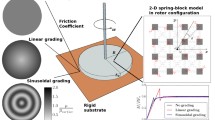Abstract
For some important knots, closed-form solutions are presented for the holding forces which are needed to keep a knot in equilibrium for given pulling forces. If the holding forces become zero for finite pulling forces, the knot is self-locking and is called stable. This is only possible when, first, the friction coefficient exceeds a critical value and, second, when there is additional pressure on some knot segments sandwiched by surrounding knot segments. The number of these segments depends on the topology of the knot and is characteristic for it. The other important parameter is the total curvature of the knot. In this way, the complete frictional contact inside the knot is taken into account. The presented model can explain the available experiments.










Similar content being viewed by others
References
Adams, C.: The Knot Book: An Elementary Introduction to the Mathematical Theory of Knots. American Mathematical Society (2004)
Kauffman, L.H.: Series on knots and everything. https://webeducation.com/wp-content/uploads (2019)
Gommers, M.: http://www.paci.com.au/knots.php
Bayman, B.: Theory of hitches. Am. J. Phys. 45, 185 (1977)
Maddocks, J.H., Keller, J.B.: Ropes in equilibrium. SIAM J. Appl. Math. 47(6), 1185–1200 (1987)
Crowell, B.: The physics of knots. https://www.lightandmatter.com/article/knots.html
Patil, V.P., Sandt, J.D., Kolle, M., Dunkel J.: Topological mechanics of knots and tangles. Science 367(6473), 71–75 (2020)
Lubarda, V.A.: The mechanics of belt friction revisited. Int. J. Mech. Eng. Educ. 42(2), 97–112 (2014)
Shifrin, T.: Differential Geometry: A First Course in Curves and Surfaces. http://alpha.math.uga.edu/~shifrin/ShifrinDiffGeo.pdf
Mason, S.J.: Feedback theory - further properties of signal flow graph (PDF). Proc. IRE 44(7), 920–926 (1956)
Pieranski, P., Przybyl, S., Stasiak, A.: Tight open knots. Eur. Phys. J. E 6, 123–128 (2001)
Johanns, P., Grandgeorge, P., Baek, C., Sano, T., Maddocks, J., Reis, P.: The shapes of physical trefoil knots. Extrem. Mech. Lett. 43, 101172 (2021)
Fuss, F., Niegl, G.: Understanding the mechanics of dynamic rope brakes. https://www.sciencedirect.com/science/article/pii/S1877705810004066 (2010).
Published on the author’s website sigmadewe.com in an extended version of “Frictional Mechanics of Knots”
Cantarella, J., Kusner, R.B., Sullivan, J.M.: On the minimum ropelength of knots and links (PDF). Invent. Math. 150(2), 257–286 (2002)
Diao, Y., Ernst, C., Por, A., Ziegler, U.: The ropelengths of knots are almost linear in terms of their crossing numbers. J. Knot Theory Ramif. 28(14), 1950085 (2019)
Acknowledgements
The author thanks Ira Leuthäusser for helpful discussions and critical reading of the manuscript.
Funding
The author received no financial support for the research, authorship and/or publication of this article.
Author information
Authors and Affiliations
Corresponding author
Ethics declarations
Conflict of interest
The author declares no potential conflicts of interest with respect to the research, authorship and/or publication of this article.
Additional information
Publisher's Note
Springer Nature remains neutral with regard to jurisdictional claims in published maps and institutional affiliations.
Rights and permissions
Springer Nature or its licensor (e.g. a society or other partner) holds exclusive rights to this article under a publishing agreement with the author(s) or other rightsholder(s); author self-archiving of the accepted manuscript version of this article is solely governed by the terms of such publishing agreement and applicable law.
About this article
Cite this article
Leuthäusser, U. Frictional mechanics of knots. Arch Appl Mech 94, 1041–1053 (2024). https://doi.org/10.1007/s00419-024-02566-w
Received:
Accepted:
Published:
Issue Date:
DOI: https://doi.org/10.1007/s00419-024-02566-w




